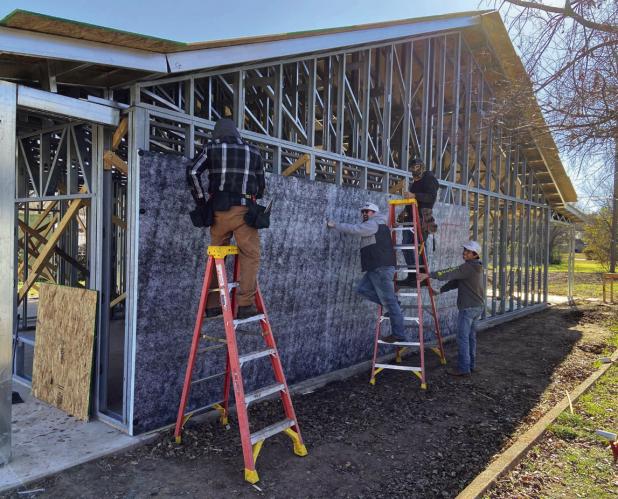
Interview: D.R. Horton founder Terry Horton has plans for Olney
The co-founder of America’s largest homebuilder was in Olney last month surveying construction on a house on West Oak Street that could solve the U.S. housing shortage while building cheaper, cleaner, and more rugged homes.
Terry Horton who founded D.R. Horton with his brother Charles in 1978, was on site on Dec. 20, watching crews from contractor GrovesPK attach laminated foam panels to a steel skeleton at 305 W. Oak Street.
Lance and Corey Groves of Graham pledged to build affordable housing in Olney as part of a streaming series to bring attention to the lack of affordable housing in rural Texas. Last year, they completed the first of 10 planned homes - a three-bedroom home on West Oak Street that was under contract to a local family, Lance Groves said.
The brothers connected with Mr. Horton after doing construction work on the Possum Kingdom home of a current D.R. Horton executive and explaining their Olney project. The homebuilder offered the Groves the use of several floor plans, and Mr. Horton showed them a new way to build their affordable homes faster and cheaper and with less environmental impact.
The brothers were learning how to use the panels and light-gauge steel to build the homes at the West Oak Street location before filming their crews building one from start to finish, Mr. Groves said.
Mr. Horton, who holds a doctorate in organic chemistry, told the Enterprise that he first became interested in building “energy efficient, safe … affordable” homes after the 2010 earthquake in Haiti.
“I kept thinking, there’s gotta be a system that acts like a true monolithic building system that absorbs energy like nothing else would,” Mr. Horton said. “That got me kind of doing some different testing here and there, and kind of experimenting.”
Six years later, he got a call from the Massachusetts Institute of Technology, inviting him to come to the first SOLVE conference to solve “the four biggest problems facing humanity: food, health, education, and climate change,” he recalled.
The MIT academics wanted his practical knowledge of homebuilding, but they convinced him to try alternatives to “sticks and bricks” building that has dominated U.S. homebuilding for 150 years, he said.
He spent the following eight years coming up with a product called “extruded polished iron foam” – panels produced at a plant in Glen Rose, Texas that take the place of siding and insulation and can also be used as roofing material.
He built the first model home using the new materials in Hazel, Texas, using four-inch panels and quickly discovered that the foam insulation cut utility bills dramatically.
The panels can be manufactured from two to eight inches thick and are designed to hang on lightgauge steel frames - saving 45 mature hardwood trees per 1,500-square-foot house, Mr. Horton said.
Tests show that the panels do not burn [they melt], they do not grow mold or mildew when wet, and repel softball-size hail, he said.
Despite the panels’ relatively light weight, they can withstand an earthquake of magnitude 11.8plus on the Richter scale, according to seismic tests performed by the University of Lima, Peru, where Mr. Horton was invited to build 7,000 homes, he said.
“We ought to be able to cut our insurance costs by at least 30 percent,” he said.
Mr. Horton said the U.S. housing deficit of about 8 million homes arose from a rise in land and construction prices. “The average builder can’t meet the need of affordable housing, so this is not only going to be affordable to purchase, it’s real affordable to live in.”
Mr. Groves said the new materials are easier to work with for contractors and workers. “We have reduced three outside building components just by switching to this, which really speeds it up,” he said.
To listen to the full interview with Mr. Horton, go to the Enterprise YouTube channel.
